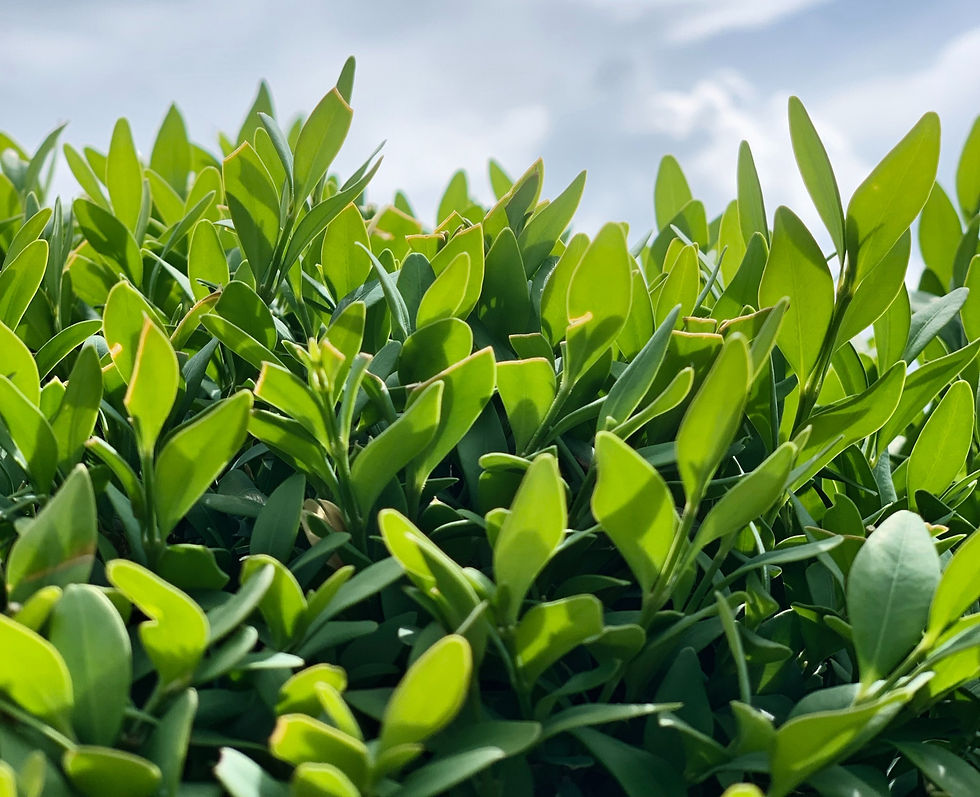An Unexpected Epidemic: Battling Boxwood Blight and Related Diseases
- Kevin Lester

- Mar 7, 2024
- 3 min read
Updated: May 17, 2024

Boxwoods, once considered among the hardiest shrubs boasting beautiful year-round color, have faced an unforeseen onslaught of pests and diseases. While the possibility of encountering these issues always existed, they were rarely common and seldom fatal. However, in December of 2022, everything changed.
During the three days leading up to Christmas, subzero temperatures combined with windchills as low as -30° wreaked havoc on many plants, including boxwoods. While some damage was immediately apparent, other effects only surfaced in the following spring and summer as diseases capitalized on the compromised immune systems of the plants. As a result, pests and diseases have proliferated, wreaking havoc and causing noticeable damage across landscapes.
Among the primary adversaries threatening boxwoods are:
Boxwood Blight:

Boxwood blight, caused by the fungus Calonectria pseudonaviculata, poses a significant threat to boxwood plants. This disease manifests as dark leaf spots, defoliation, and dieback, ultimately leading to the decline and death of affected plants. Prevention strategies include proper sanitation practices, such as disinfecting tools between pruning sessions, and avoiding overhead irrigation to reduce moisture levels that favor fungal growth. Fungicidal treatments may also be employed as a preventative measure, particularly during periods of high humidity and warm temperatures.
Volutella Blight:

Volutella blight, caused by the fungus Volutella buxi, commonly emerges following severe winter damage or other stressors to boxwood plants. Symptoms include pinkish-orange spore masses on affected foliage, as well as dieback of stems and branches. Mechanical treatment, such as pruning infected portions of the plant and ensuring proper air circulation, remains the primary management strategy. Additionally, maintaining optimal growing conditions, including adequate moisture levels and soil drainage, can help mitigate the spread of this disease. Liquid root feeding is recommended to build the root system and promote the health and vitality of your boxwood plants.
Boxwood Leafminer:

The boxwood leafminer (Monarthropalpus flavus) is a common pest that infests boxwood foliage, causing characteristic blister-like mines on leaves. While the damage inflicted by leaf miners typically does not result in the death of the plant, severe infestations can lead to aesthetic decline and reduced plant vigor. Management options include cultural practices, such as pruning and removing infested foliage, as well as the application of systemic insecticidal treatments targeting larvae and adult leafminer flies for comprehensive pest control.
Winter Desiccation:

Winter desiccation, or winter burn, occurs when boxwood plants lose moisture through their foliage during periods of cold temperatures and low humidity. This phenomenon often becomes evident in late winter or early spring, presenting as browning or scorched foliage. To minimize the risk of winter desiccation, it is essential to provide adequate moisture to plants, especially during dry winter months. Mulching around the base of boxwoods and employing anti-desiccant sprays can also help retain moisture and protect plants from the drying effects of winter weather.
Boxwood Tree Moth:

The boxwood tree moth (Cydalima perspectalis) is an invasive pest that poses a significant threat to boxwood plants. The larvae of this moth feed voraciously on boxwood foliage, resulting in defoliation and weakened plant health. Control measures for the boxwood tree moth include the use of insecticidal treatments targeting larvae and pupae, as well as the implementation of monitoring programs to detect and manage infestations early. Additionally, promoting biodiversity and avoiding the planting of susceptible boxwood varieties can help reduce the risk of infestation by this destructive pest.
The landscape has shifted dramatically, underscoring the importance of proactive measures to safeguard against these threats. As we continue to navigate this unexpected epidemic, prioritizing prevention and swift intervention remains essential in preserving the vitality and beauty of boxwoods in our gardens and landscapes.
In the face of these challenges, our team of Board Certified Master Arborists and Certified Arborists at Gregory Forrest Lester Inc. remain vigilant in monitoring and addressing the diseases and pests affecting boxwoods in the Cincinnati area. With our expertise and dedication, we are at the forefront of implementing effective management strategies to protect and preserve boxwood health. Whether it's combating boxwood blight, volutella blight, or other emerging threats, we are committed to safeguarding your landscape investment. Don't wait until it's too late – reach out to Gregory Forrest Lester Inc. today, and let us defend your boxwoods against these relentless adversaries.

